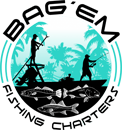Last Updated on October 1, 2025 by Capt. Bucky
When it comes to redfish here in Tampa Bay there are so many different ways to approach it. Redfish eat a wide variety of things from fish to crustaceans, so it is always nice to have plenty of options. When and where to target them can change throughout the day with the tides as well as with the seasons when the temperatures change and their primary food source changes.
Here in Tampa Bay the primary live bait being used are scaled sardines and other white bait. These hardy baits are plentiful, especially during the warmer months and you can really black out your live wells. Meaning that you can keep a lot of bait jammed packed and alive. This comes in handy when you are using the chumming method. Tossing a handful of disoriented bait out there and watching the fish react to the injured bait. A fish is always more likely to go for an injured and easier pray to catch. Come up on a school of hungry reds and you can start a feeding frenzy.
Pinfish are also one of my favorite baits to use. These frisky and strong baits never give up and will last a long time on the hook. I change up how I use them depending on the situation. Sometimes I like to bomb them out as far as I can and let them sit inside schools of mullet, or on the edges of flats. Other times, pitching them under the mangroves will also get them crushed. If they tend to keep swimming out of the mangroves, I will often cut just their tails off. They will still stay alive for a considerable amount of time, but they will also still try to swim and those vibrations and scent will attract redfish, snook, trout, and just about anything else.
During the colder fall and winter months, live bait can sometimes be hard to come by. That is where shrimp and crabs come into play. Everything loves eating shrimp and redfish will almost always slurp down a tasty shrimp. I like to pinch of the tails and hook them from the bottom of the tail up. They will cast much further and will also put out more scent this way. Sight casting a shrimp to a school of tailing redfish will most certainly get you hooked up.
Threadfin hearing will work extremely well, but they will not stay alive for long periods of times. You also can’t pack down your live wells with them as they will quickly die. These sensitive baits are great to have when you can’t get scaled sardines or pinfish. Which bring me to the point of cut bait fishing.
Cut bait is a different story and you can use most anything to catch redfish. The primary cut bait I use are pinfish, threadfins, and ladyfish. When fishing with cut bait I like to cast as far from the boat as possible. Using larger chunks can easily accomplish this. The further away from the boat the less spooky redfish will be. Medium to large pin fish, are what I prefer to use. Cut the tail off, cut it in half and you have two nice pieces of bait. It’s not uncommon to catch multiple fish on one piece of bait. You can do the same with Threadfins. A split shot can be helpful if there is a decent current or stronger winds. Remember that dead bait doesn’t move, so set it and forget it. Just don’t leave too much slack in the line or the redfish will swallow the hook. Too much tension on the line, and the fish will pick it up, feel the pressure, and drop it. Focus on areas that have deep undercuts under the mangroves or on the flats within or near schools of mullet.
Cut ladyfish are probably my favorite cut bait, Ladyfish are soft, slimy, and stinky baits that can be casted an absolute mile from the boat. A piece of bait about the width of two fingers works well. I like to hook the through the flesh and out through the skin using a 2/0 to 3/0 Owner Mutu light circle hook. 20 to 30-pound test leader is where I like to sit around. Again, set it and forget it. Allow “Rodney” the rod holder to fish for you. He never panics!
Blue crabs also work well depending on the size they can be fish whole or in chunks. Same methods apply when fishing crab. Crab work really well around bridges and deeper water. You also have a greater chance of hooking a black drum as well.
Catching redfish doesn’t have to be a struggle. Your main focus should be the areas you fish and how to approach them. Be patient, let the bait do the work, and let the fish come to you. Chasing schools of redfish on a trolling motor will often lead to poor results. There is a reason why you find fish in certain areas. Once you bump into some, or a lot, sit tight. Let them settle down and often they will come back. Fishing is fun and it doesn’t have to be rocket science.


